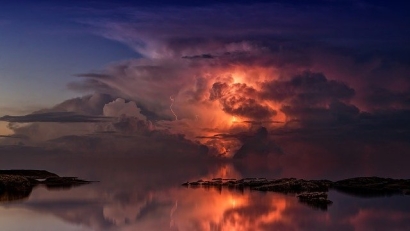
In pursuit of clean energy, some scientists and engineers are working to harness the power of natural disasters for human use. If the energy from disaster events like hurricanes and tornadoes could be captured and stored, it could reduce or even eliminate the use of fossil fuels. However, harnessing energy from natural disasters is incredibly difficult.
Engineers face several challenges when trying to capture energy from natural disasters. First of all, extreme weather events like hurricanes and tornadoes are unpredictable. People generally discover they’re coming with just enough time to evacuate before a storm hits. Storm location, direction, and intensity vary with every event.
Secondly, scientists have not been able to develop a form of energy capture that’s reliable in extreme weather events. This technology would need to be incredibly strong to withstand weather conditions without being destroyed. However, energy capture technology would also need to be mobile so it could translate motion into stored energy.
Another issue is where and how to store excess energy. The average tropical hurricane releases 600 terawatts of energy – enough to fuel the world’s energy needs for years. Unfortunately, the technology needed to store this extreme amount of energy hasn’t been developed yet. Battery capacity needs to be developed alongside storm-proof technology in order for captured energy to be useful.
Despite the difficulties, many engineers are working to develop technology that can capture energy from natural disasters. Each type of disaster presents different challenges and opportunities for energy capture. In general, natural disasters that occur on a small scale hold the most potential for gathering clean energy.
Hurricanes form when water in the ocean heats up and evaporates. As the process continues, this water vapor turns into a large storm system of moving air. Because they rely on heat and begin over the ocean, hurricanes tend to affect coastal areas that experience warm, tropical weather.
In 2020, there were seven hurricanes in tropical regions. Although hurricanes are somewhat predictable, they’re incredibly destructive. Most of their energy is contained in water vapor, with a tiny portion caught up in wind. To date, there’s been little to no success with harnessing the energy from a hurricane.
Like hurricanes, tornadoes are unpredictable and can be incredibly destructive. They form when warm air interacts with cool air to create a mass of swirling wind. While hurricanes contain many thunderstorms, tornadoes come from just one. Most of a tornado’s energy is contained in strong winds.
Although harnessing large tornadoes has proven impossible, engineers are experimenting with small, human-made tornadoes. These spinning vortexes are created within a controlled environment and are meant to power turbines that produce energy. While these experiments show promise, they’ve not yet broken into the energy industry.
Earthquakes also transfer massive amounts of energy. However, like other natural disasters, their location and scale are highly unpredictable. In addition, it’s difficult to build a technology that could capture the energy of an earthquake without being broken in the process.
In 2016, students at the University of Leicester worked on a device that generated energy by shaking during an earthquake. According to their calculations, this invention could effectively power emergency systems in a building. However, while this device would be very useful in an emergency situation, it isn’t a long-term solution for energy needs.
Ocean waves have led to some of the most promising innovations so far. Engineers are experimenting with buoys that can generate electricity from the natural motion of ocean waves. These buoys are designed to withstand storm events and generate electricity for their duration. Although this industry is young, it looks very promising.
In some countries, underwater turbines are already being used to capture energy from changing ocean tides. This technology could potentially be adapted to capture energy from the force of moving water during storm events. However, storm turbines would need to withstand strong currents and securely route captured energy to land.
Many environmentalists believe that current forms of energy are exacerbating natural disasters. For example, burning fossil fuels contributes to higher temperatures and hurricanes and tornadoes around the world. If the energy from these disasters could be safely captured, society could reduce its reliance on fossil fuels.
Although there have been some breakthroughs in capturing energy from nature, it’s currently impossible to efficiently harvest energy from natural disasters. These events are too unpredictable to become a reliable source of clean energy. However, scientists are finding success in capturing energy from calmer weath

